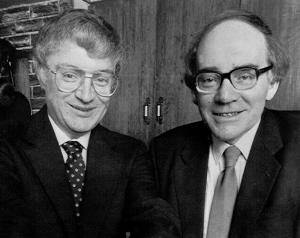Cold fusion
End of story?
15 Jul 2019
-
R.A.
Thirty years ago, two electrochemists at the University of Utah, Martin Fleischmann and Stanley Pons, created a sensation when they claimed they had achieved fusion at room temperature in a tabletop experiment.
Martin Fleischmann, right, with Stanley Pons, in 1989. The team of electrochemists from the University of Utah claimed they had acheived hydrogen fusion at room temperature. Thirty years later, having invested USD 10 million in research, Google confirmed in May that they had found "no evidence whatsoever" in favour of cold fusion.
The concept of "cold fusion" was not new. As early as the 1920s, physicists had speculated that the fusion of hydrogen could occur in an electrolytic cell in the presence of a palladium catalyst.
The theory failed to receive much consideration until the Fleishmann-Pons announcement in March 1989. Although the experiment's detailed protocol was not divulged, the scientific status of Fleischmann, then one of the world's leading electrochemists, lent credibility to the claim.
Researchers and labs throughout the world attempted to reproduce the experiment, but failed to obtain conclusive results. A major controversy ensued, the scientists' "honesty" was challenged, and major scientific journals and institutions eventually closed the case as pipe dream or worse—as a blatant example of "pathological science."
This reaction from mainstream science did not deter hundreds of scientists throughout the world from pursuing the quest. In 2015, more than a quarter century after the Fleischmann and Pons experiment, Google launched a research program of its own.
The USD 10-million project was revealed to the general public in May when researchers with the Internet giant admitted that they had found "no evidence whatsoever" in favour of cold fusion.
Google's lack of results, however, is not likely to put an end to the pursuit. Like the quest for the philosophers' stone, the dream of cold fusion will endure and keep modern-day alchemists busy.


